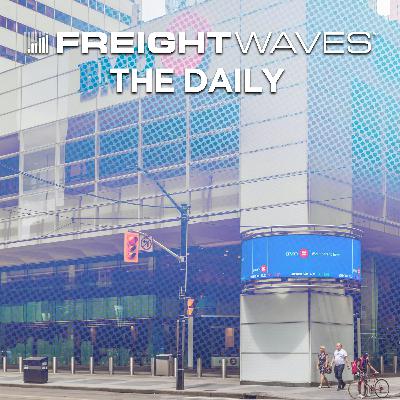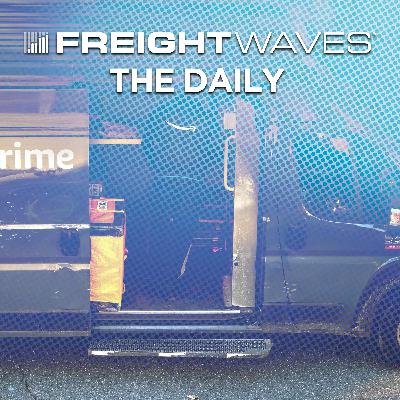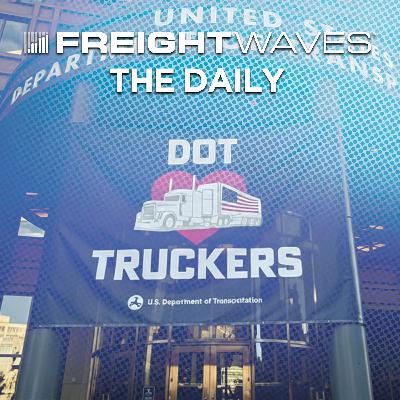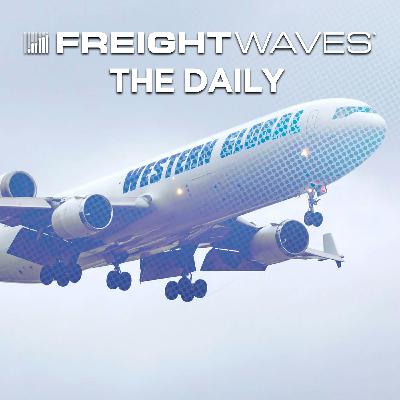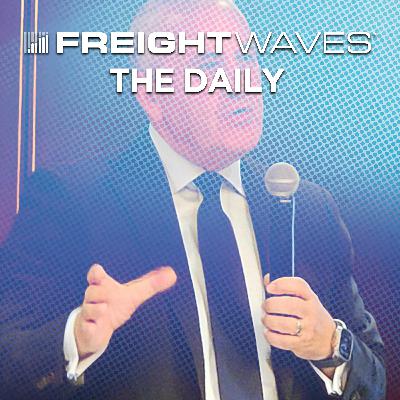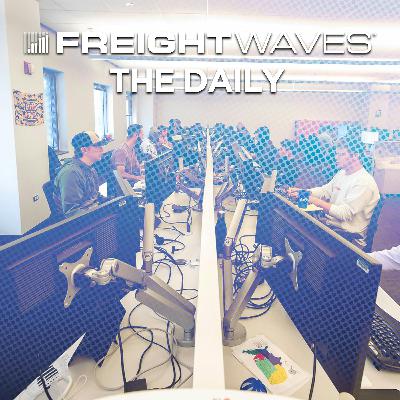Discover FreightWaves NOW
FreightWaves NOW

2069 Episodes
Reverse
A federal appeals court has granted a request to hold the lawsuit regarding non-domiciled CDL restrictions in abeyance while the agency reviews public comments. This decision temporarily halts the interim final rule, meaning the FMCSA gets time-out on CDL crackdown and nearly 200,000 trucking jobs remain protected under previous standards for now.
Beyond the courtroom, industry experts argue that a focused English-language crackdown exposes how cheap labor and CDL fraud are remaking trucking by revealing a "new ecosystem" of transient foreign drivers. Grace Maher of OTR Solutions explains that drivers from Eastern Europe and Asia are suppressing freight rates by entering the market temporarily to undercut prices before returning home.
In infrastructure news, the Indiana port expands barge steel capacity at Jeffersonville by 40% to accommodate consistent double-digit growth and strong demand. Indiana River & Rail Terminals has leased a fourth building, raising their total storage capacity to 350,000 square feet to better serve multimodal customers.
Finally, stay tuned for a new episode of WHAT THE TRUCK?!? airing live at noon on FreightWaves TV with Malcolm Harris. If you miss the live broadcast, you can catch the replay on the FreightWaves YouTube channel.
Learn more about your ad choices. Visit megaphone.fm/adchoices
In this episode, we investigate a safety crisis on American highways as industry leaders expose a loophole allowing thousands of fraudulent training providers to operate. We also analyze a pivotal legal battle reaching the U.S. Supreme Court that could redefine whether freight brokers are liable for negligent hiring.
Major U.S. ports are raising alarms that a proposed consolidation of rail carriers could severely reduce competition and threaten infrastructure investments. Simultaneously, agricultural leaders are urging for policy changes to overcome tariffs and regulatory "self-inflicted wounds" hindering trade.
Market data reveals a tightening environment where retailers are facing a sudden spike in transportation costs despite stalled capacity. These economic pressures are mirrored in the financial sector, where rising credit losses for major lenders point to a deepening struggle for carriers.
Learn more about your ad choices. Visit megaphone.fm/adchoices
New research from ATRI indicates that pre-crash negligence, such as substance abuse allegations, is driving a massive increase in jury awards against trucking companies. This analysis suggests that organizational failures now carry financial multipliers that far exceed those associated with crash severity alone.
In payment news, Relay Payments has secured a deal with Travel Centers of America, completing its coverage of the "big three" travel center providers alongside Love's and Pilot. This expansion allows the digital payment platform to service fleets of all sizes with a network that now encompasses roughly 90% of the high-flow diesel market.
Finally, SpeedX has opened a new e-commerce superhub in Chicago capable of processing 500,000 shipments daily as part of its rapid U.S. expansion. This strategic move highlights how independent parcel carriers are building nationwide networks to compete directly with FedEx and UPS for last-mile dominance.
Later today on FreightWaves TV, tune in to The Long Haul for a conversation with Danielle Spanelli regarding rail theft and compliance. You can catch the episode at 10 a.m. or watch it on the FreightWaves YouTube channel.
Learn more about your ad choices. Visit megaphone.fm/adchoices
This episode of FreightWaves Daily unpacks a massive safety crisis involving fraudulent CDL schools, where a regulatory loophole has allowed unqualified drivers to self-certify without state oversight. New enforcement measures are projected to remove nearly 200,000 drivers from the road, creating a high-stakes trade-off between highway safety and available capacity.
State officials and industry leaders are warning that this rapid reduction in the driver pool could severely disrupt supply lines and increase operational costs. We examine the tension between these necessary safety crackdowns and the potential for a severe economic shock.
Shifting to market signals, the latest data reveals that transportation capacity has stalled while pricing continues to surge for downstream retailers. In a historic shift, warehousing utilization contracted for the first time in nine years as long-standing inventory backlogs finally clear.
On the rails, a major proposed merger between Union Pacific and Norfolk Southern threatens to reduce the sector’s competition from four major players down to just two. East Coast ports are raising alarms that a seamless transcontinental route could undermine their infrastructure investments by favoring West Coast dominance.
Finally, we discuss the infrastructure challenges facing pure electric trucks following the removal of federal EV tax credits. The conversation highlights hybrid engineering, such as the onboard generators used by Edison Motors, as a practical bridge to overcome range anxiety.
Learn more about your ad choices. Visit megaphone.fm/adchoices
Union Pacific has delayed their rail merger filing for its proposed combination with Norfolk Southern until mid-December. The 4,000-page application faces significant opposition from other Class I railroads and shippers concerned about the effects of consolidation.
In automotive news, Michigan-based Bollinger Motors shuts down amid financial woes after missing payroll for at least two periods. The EV truck maker has ceased operations, leaving the future of its parent company, Bollinger Innovations, uncertain as it executes a cost-reduction plan.
Finally, Amazon tests 30-minute delivery in two US cities using urban micro-fulfillment centers to speed up orders for groceries and household essentials. This pilot program in Seattle and Philadelphia employs Amazon Flex workers to deliver goods rapidly, with fees varying based on Prime membership status.
Learn more about your ad choices. Visit megaphone.fm/adchoices
10 Roads Express will shut down operations and end its USPS contracts. This wind-down represents the largest trucking failure since Yellow, removing thousands of trucks from the road following severe revenue losses.
We also examine the stark divergence in global shipping, where Asia-US container rates fell 32% in a single week due to overcapacity. Conversely, Asia-Europe rates have surged effectively by 40% as carriers navigate complex security issues in the Red Sea.
On the regulatory front, the DOT is cracking down on safety standards by kicking 3,000 truck driver trainers off its registry for failing to meet new federal requirements. Additionally, the FMCSA has introduced a new ELD approval overhaul to combat the "ghost driver" fraud that contributed to fatal crashes.
Finally, we discuss the confusion surrounding commercial licensing after a federal court intervened in the legal battle regarding non-domiciled CDLs. While the court stayed the FMCSA's emergency rule, uncertainty remains as many states are reluctant to issue credentials to the 200,000 affected drivers.
Learn more about your ad choices. Visit megaphone.fm/adchoices
10 Roads Express to shut down operations, end USPS contracts and terminate its postal agreements by late January. The major mail hauler plans to complete its remaining service obligations despite a recent history of labor disputes with the Teamsters.
The episode also covers Inside the Amazon-Teamsters showdown: What’s next?, highlighting a union victory for drivers in Kentucky alongside legislative battles in New York,. Additionally, federal proceedings at the NLRB continue to assess whether Amazon should be classified as a joint employer for delivery drivers.
In regulatory news, the DOT kicks 3,000 truck driver trainers off registry for failing to meet federal service standards. The FMCSA has placed thousands more on notice regarding potential noncompliance issues involving falsified data and curriculum failures.
Tune in to FreightWaves TV later today for new episodes of Check Call and Loaded and Rolling. Listen to this brief update to stay ahead of the most critical stories shaping the freight and logistics industry.
Learn more about your ad choices. Visit megaphone.fm/adchoices
This week, we examine the unprecedented regulatory storm targeting the U.S. trucking labor market, which combines aggressive DHS I-9 audits with powerful financial enforcement by FinCEN. These federal pressures, including stricter CDL requirements, are accelerating the market capacity correction by forcing thousands of non-compliant drivers out of the industry and stabilizing depressed freight rates.
The air freight sector is simultaneously reeling from a severe, unexpected capacity crunch right at the peak shipping season. We detail why FedEx canceled all MD-11 cargo flights for December following the discovery of fatigue cracks, representing an 8% loss of mainline capacity for the carrier and causing disruption for UPS and Western Global Airlines.
We also look south to the U.S.-Mexico border, where massive nationwide blockades organized by truckers and farmers have recently been lifted after they successfully reached deals with federal authorities on security and subsidies. Finally, we cover major corporate finance news, including Yellow Corp.'s massive $7.4 billion pension withdrawal liability being settled for approximately $1.5 billion, alongside a New Jersey truck school's costly misclassification settlement.
Learn more about your ad choices. Visit megaphone.fm/adchoices
Overcapacity in the Trans-Pacific container trade lanes nullified November general rate increase plans, causing prices on Asia to US West Coast lanes to drop 32% last week to $1,900 per FEU. We discuss the latest data on falling East Coast rates and the continued emphasis on container shipping challenges, including the potential return of traffic to the Suez Canal route amid Red Sea tensions.
Mexican truckers and farmers have begun removing highway and border blockades after reaching agreements with federal authorities to address concerns over escalating highway insecurity, rising cargo theft, and overdue subsidy payments. These disruptive protests severely impacted cross-border shipments, with trade leaders estimating the economic impact at about $3 million per day in lost cross-border salaries and revenue.
Additionally, a North New Jersey truck driving school agreed to settle a lawsuit after being accused of misclassifying at least 30 driver instructors as independent contractors. The settlement includes a total gross payment of about $345,000 to the affected instructors, alongside payments of over a quarter million dollars to the state for penalties and costs, highlighting the enforcement of the ABC test used to classify workers in New Jersey.
Learn more about your ad choices. Visit megaphone.fm/adchoices
This episode highlights Airbus kicking its A350 freighter program into high gear, with the prototype finalized and flight tests set for next October, aiming for a late 2027 service entry. Learn how the A350F promises a 40% reduction in fuel consumption and features a massive 175-inch wide cargo door, giving it a significant edge in handling bulky industrial cargo.
We also examine major rail consolidation, specifically the Surface Transportation Board approval of Fortress Investment Group's acquisition of two new regional lines, the Wheeling & Lake Erie Railway and the Akron Barberton Cluster Railway. This deal expands Fortress's roster of Class III railroads, and the STB agreed that the move would enhance the railways' access to capital for strategic investment and growth.
Finally, we cover the worrying financial distress facing the 3PL sector as Odyssey Logistics was hit with a second debt downgrade from Moody's in less than three months, dropping its corporate family rating deep into Caa-1 "junk status". Moody's noted this rapid deterioration was driven by sky-high leverage—expected well over seven times operating profit—which creates serious refinancing risk ahead of the company's significant debt maturities in 2027.
Learn more about your ad choices. Visit megaphone.fm/adchoices
Welcome to the daily market update focusing on critical friction points that are reshaping the supply chain. We examine the accelerated federal crackdown, including Border Patrol turning back two Mexican truckers in Arizona, and how tech firms like Highway are responding with new broker screening features for non-domiciled CDL drivers.
While new compliance technology risks reducing available trucking capacity, potentially pushing spot market freight rates up, the industry is simultaneously enduring a massive labor contraction across the entire sector. Over 11,900 workers were laid off in five weeks due to diverse factors like slower electric vehicle adoption at General Motors and a national cattle shortage leading to major plant closures at Tyson Foods.
On the international front, Maersk has denied setting any fixed timeline for a Red Sea return, stating safety remains their top priority, which ensures continued reliance on longer, more expensive shipping routes around Africa. Amidst these challenges, the industry is responding with data-driven initiatives like the FMCSA to poll 'several thousand' drivers on truck parking and groundbreaking rail decarbonization using a new deal to take carbon out of the LA-Long Beach harbor railroad.
Mentioned Articles:
Border Patrol turns back two Mexican truckers in Arizona
Highway’s new feature allows brokers to screen carriers with non-domiciled CDL drivers
Layoffs slam transport, logistics, manufacturing sectors ahead of the holidays
Maersk: No timeline for Red Sea return
FMCSA to poll 'several thousand' drivers on truck parking
New deal to take carbon out of LA-Long Beach harbor railroad
Learn more about your ad choices. Visit megaphone.fm/adchoices
We start with major security vulnerabilities, as authorities in the U.S. and Canada are intercepting millions in narcotics cleverly hidden within legitimate shipments, including a $16 million meth bust found in plaster vases. Tune in to hear more about these enforcement actions, where drugs have been concealed in commodities ranging from auto parts and berries to lettuce.
The conversation then shifts to the back office, where new technology is being utilized to fight freight fraud and enhance compliance. We discuss Highway’s new, optional feature that allows brokers to screen out carriers based on whether the primary account owner holds a non-domiciled CDL, a major red flag for liability and fraud concerns. This compliance effort is a direct response to increased insurer scrutiny and regulatory pressure surrounding non-domiciled licenses.
Finally, we issue a critical warning concerning the Thanksgiving holiday period, as Verisk CargoNet has put out a massive cargo theft alert. Organized criminal networks are expected to cause a 65% increase in theft incidents compared to last year, primarily targeting food and beverage shipments. Vigilance, advanced security measures, and the right technology are absolutely essential for supply chain planning this quarter.
Learn more about your ad choices. Visit megaphone.fm/adchoices
We explore why BNSF Railway opposes the proposed UP-NS mega-merger, arguing it would eliminate competitive options for shippers and fail the strict Surface Transportation Board standard requiring mergers to actively enhance competition.
The air freight sector faces an immediate capacity crisis due to two simultaneous events hitting just before peak season. Learn how the extended grounding of MD-11 freighters—following the discovery of fatigue cracks after a fatal UPS crash—has led to indefinite pilot furloughs at Western Global Airlines, while a BP pipeline leak near Everett, Washington, forced United Airlines to place a temporary embargo on most narrowbody cargo shipments at Sea-Tac airport.
Financial pressure continues in the trucking sector, exemplified by the Chapter 11 bankruptcy filing of P. Judge & Sons, a legacy firm whose high vehicle out-of-service rate (46.2%) stood out as significantly worse than the national average. Conversely, bipartisan regulatory relief may be coming for drivers in cold climates through the "Cold Weather Diesel Reliability Act of 2025," which aims to prevent automatic engine shutdowns in extreme cold (below 12° F) by requiring the EPA to authorize the suspension of derate functions.
Finally, we examine the intense cross-border risk in Mexico, where massive highway blockades across more than 20 states are snarling major corridors, causing anticipated transit and customs delays. These widespread protests, driven by truckers demanding action against rampant cargo theft and police extortion, underscore the critical necessity for supply chain professionals to diversify planning and build resilience against simultaneous regulatory, financial, and physical threats across all transportation modes.
Learn more about your ad choices. Visit megaphone.fm/adchoices
The 100-year-old P Judge and Suns Trucking and Warehousing Company filed for Chapter 11 bankruptcy protection in New Jersey, listing both assets and liabilities between $1 million and $10 million.
The podcast covers the ongoing debate surrounding the proposed merger between Union Pacific and Norfolk Southern, which UP CEO Jim Vena advocated for at the RailTrends industry conference. Vena stressed that the United States should not be the only country in North America without seamless rail service, noting that the merger is necessary to enable railroads to compete with the trucking industry.
Strong opposition to the deal comes from Western Railroad BNSF, which views the merger as a disruption that would likely lead to a reshaping of the entire North American Rail Network. BNSF’s chief marketing officer highlighted that customers are not advocating for the merger, and that existing transcontinental options are already practical through collaboration.
Learn more about your ad choices. Visit megaphone.fm/adchoices
Experts at the Trimble Insight conference are forecasting a "significant reduction" in employment levels as rapidly maturing AI tools become cheaper and more efficient than human workers.
This technological shift is already translating into measurable gains, with companies like C.H. Robinson openly connecting rising profitability directly to a shrinking workforce. However, achieving the full strategic potential of AI requires clean and comprehensive data, meaning much of the current investment is directed toward routine tasks that don't rely on perfect data, such as calling drivers or getting quotes.
Regulation is increasing alongside technological pressure where the Department of Transportation is developing a data-driven severity scoring system to proactively identify and shut down dangerous "chameleon carriers". This federal crackdown will flag patterns of fraud, including shared addresses and recycled phone numbers, while also reflecting heightened attention to operational risks, such as the electrical fire that shut down four terminals at the Port of Los Angeles following an explosion on the ONE Henry Hudson.
We also analyze the high-stakes future of North American rail with the proposed Union Pacific and Norfolk Southern merger necessary to compete effectively with the evolving trucking sector. Nevertheless, analysts are highly skeptical of the forecast for 10% volume growth within three years given the rail industry's decade of flat volume, ensuring the Surface Transportation Board will conduct a stringent and independent review.
Finally, we touch upon the tentative contract agreement reached between Canada Post and its largest union after two years of contentious talks, which came right after Canada Post reported a record quarterly loss of $385 million. Ultimately, the intense demands from AI and the new government scrutiny raise a critical question for managers across the supply chain: how quickly will clean data become the single most defining competitive advantage in the entire freight ecosystem?
Learn more about your ad choices. Visit megaphone.fm/adchoices
The container ship ONE Henry Hudson was towed out to anchorage at the Port of Los Angeles after an electrical fire that began onboard while it was berthed was substantially contained. The incident temporarily suspended port operations, closed four of the seven container terminals, and led to a mile-wide safety zone, though no injuries were reported among the 23-person crew.
Canada Post and the Canadian Union of Postal Workers reached a tentative collective bargaining agreement following over two years of bitter negotiations and strike activity by more than 50,000 mail carriers. The agreement comes as the national mail carrier reported a record quarterly loss of $385 million due to labor actions causing businesses to switch carriers, resulting in a 40% drop in parcel revenue.
South Carolina truck driver Dennis Eugene West and his company pleaded guilty to negligent discharge of pollutants after West crashed while driving under the influence in West Virginia. The August 2022 crash spilled thousands of gallons of alkyl dimethylamine into Paint Creek, which temporarily harmed aquatic life, resulting in West and the company facing over $1.6 million in restitution and penalties.
Learn more about your ad choices. Visit megaphone.fm/adchoices
A preliminary investigative report has been released by the National Transportation Safety Board regarding the fatal UPS MD-11 freighter crash in Louisville. The report cited fatigue cracks in the left-wing engine mount, which separated shortly after liftoff, leading UPS to continue grounding its remaining MD-11s per FAA guidelines, a situation explored further in "NTSB links fatigue cracks to fatal crash of UPS cargo jet - FreightWaves".
The broadcast also covers Walmart’s impressive Q3 performance, which included a 27% jump in global e-commerce sales and a nearly 70% increase in sales for same-day delivery. Walmart continues to leverage its pickup and delivery options, asserting that it can now deliver to about 95% of U.S. households in under three hours, a popular expedited choice examined in "Walmart e-commerce sales rise 27% as shoppers opt for same-day delivery - FreightWaves".
Finally, we review the delayed September employment report, which showed truck transportation jobs slid by one of the biggest drops seen in three years, contributing to a total transportation job decrease of 6,800. With job losses detailed in "Trucking employment down in Sept from August, mostly flat over 12 mos - FreightWaves," experts suggest we should expect continued drops in this sector as regulation continues to tighten up with drivers.
Learn more about your ad choices. Visit megaphone.fm/adchoices
The U.S. freight market is grappling with a massive security crisis as cargo theft surges 29% in Q3 driven by organized crime targeting electronics and high-value pharmaceuticals. We analyze how carriers must implement comprehensive security measures and establish clear policies to ensure truck cameras succeed in litigation, especially regarding how crucial video retention rules are.
The logistics industry faces a dramatic regulatory shift as the FMCSA’s tighter bond enforcement looms over freight brokers in 2026, taking full effect on January 16, 2026. These new rules mandate immediate operating authority suspension for bond shortfalls and require BMC-85 trust funds to be solely cash or cash-equivalent assets, accelerating market consolidation among poorly capitalized 3PLs.
Agricultural supply chains are under threat due to regulatory confusion, detailed in the crackdown on foreign truckers that threatens US farm labor, as states inadvertently pause CDL issuance for essential H-2A farm workers. Industry groups are urgently pushing the FMCSA to clarify this existing H-2A exemption and extend similar CDL exemptions to J-1 visa workers due to their vital seasonal role in custom harvesting.
We also cover the operational crunch in air freight, as UPS compensates for lost use of grounded MD-11 cargo jets after the mandatory grounding of its MD-11 fleet following a deadly crash. UPS is mitigating this peak season capacity gap by wet leasing supplemental lift from partners like Cargojet and Amerijet, alongside reconfiguring its ground network.
Finally, we discuss the major strategic footprint change as Maersk relocates its North American HQ to Charlotte, moving its headquarters from New Jersey to North Carolina. This relocation involves a $16 million investment and 500 new jobs, driven by Charlotte’s affordability and growing talent pool.
Learn more about your ad choices. Visit megaphone.fm/adchoices
The NTSB released its findings about the container ship Dali crash from last year, determining that an improperly placed wire label caused the cargo vessel to lose power and drift out of control into the pier of Baltimore's Francis Scott Key Bridge, causing the collapse and the deaths of six construction workers.
A.P. Moller-Maersk announced that it has selected Charlotte, North Carolina, as the new location for its North American headquarters, a move that comes after decades of having offices in New Jersey. The relocation of the North American HQ to Charlotte is expected to add 500 jobs, bringing the total Charlotte workforce to 1,300, and may earn the Copenhagen-based carrier an $8 million state grant if job creation and investment targets are met.
Meanwhile, UPS is turning to an alternate playbook to compensate for the significant capacity being lost due to the grounding of its MD-11 freighter fleet. UPS is utilizing partner airlines and its ground network during the busy shipping period to make up for the loss, wet leasing several aircraft from carriers like Canada-based Cargojet, Amerijet, ABX Air, and Air Transport International, while consolidating flight routes and reconfiguring truck routes.
Learn more about your ad choices. Visit megaphone.fm/adchoices
Dive into the proposed rail mega-merger of Union Pacific and Norfolk Southern, which Republican legislators warn threatens to raise consumer costs, reduce competition, and create "captive shippers". This controversial deal would combine systems controlling nearly 45% of all U.S. rail tonnage across 43 states, raising serious questions about long-term service reliability and inflationary pressure on American households.
The trucking market remains in a recession due to a collapse in demand and a significant industrial recession, confirmed by indices like the SONAR Outbound Tender Volume Index (OTVI). Despite low demand, the market could face a radical supply shock if estimates hold true that new immigration enforcement targeting foreign-born drivers could remove 16%, or over 600,000, of the current driver population, potentially strengthening freight rates by late next year.
We also examine the FMCSA’s new pilot program testing flexible sleeper berth split options, such as 6/4 and 5/5 hours, designed to provide more flexibility for truckers. Safety groups like OOIDA and the TCA are cautioning regulators about a high potential for driver coercion, insisting on strict safeguards and anonymous reporting methods to ensure that discretion belongs solely to the driver.
Postmaster General David Steiner is driving a "U-turn" strategy at the USPS, re-emphasizing last-mile delivery services for big shippers like UPS and Amazon to grow revenue by leveraging the agency's unique national network]. While the goal is to stop revenue decline, critics worry this move risks cannibalizing USPS's own products and empowering competitors by handling the toughest delivery segment for them. We also briefly touch on the regulatory back-and-forth seen internationally, such as the now-suspended U.S. fees on Chinese ships, which analysts warned would ultimately burden U.S. agricultural exporters.
Learn more about your ad choices. Visit megaphone.fm/adchoices


